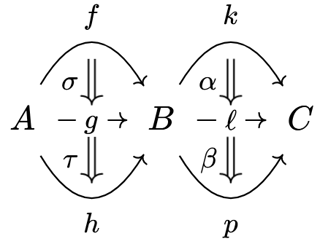This$\def\hom{\operatorname{Hom}} \def\bbZ{\mathbb{Z}}$This question is a follow-up to this other one. There the OP asks whether "the category of chain complexes" (can be interpreted in several ways) is really a 2-category. On my case I'm interested in understanding, more precisely, whether the category $\operatorname{CoCh}(\mathcal{A})$ of cochain complexes with terms in an additive category $\mathcal{A}$ is a 2-category.
Qiaochu Yuan answers that the OP has chosen the wrong definition for chain homotopy. He then proposes a new definition for chain homotopy. My problem with this answer, if I've understood it well, is that the definition depends on the existence of an interval object, which I only know how to construct in $R$-modules.
My question is: just requiring $\mathcal{A}$ to be some additive category, is there any formula for horizontal composition in $\operatorname{CoCh}(\mathcal{A})$ that yields a cochain homotopy and respects all axioms of a 2-category? (horizontal composition is associative with unit the canonical unit 2-cell, the middle four interchange holds, horizontal composition preserves vertical units...). Or maybe there cannot be such a formula?
UPDATE (27/4/23): I think I've understood what Qiaochu Yuan meant. However, from his hint I am still unable to produce a formula for horizontal composition that satisfies the law of middle four interchange. I will post my insights here anyway, in case it helps anyhow.
Define the interval object $I[R]$ in cochain complexes of $R$-modules as the cochain complex whose $(-1)$-th term is $R$, whose $0$-th term is $R\oplus R$, and where all other terms are zero. The differential $d_{I[R]}={1\choose -1}:R\to R\oplus R$. Denote $I=I[\bbZ]$. There is a bijection between cochain maps $I\to\hom^\bullet(A,B)$ (where the codomain is the internal hom) and triples $(f,g,h)$, where $f,g:A^\bullet\rightrightarrows B^\bullet$ are parallel cochain maps and $h=(h^i:A^i\to B^{i-1})_i$ is a cochain homotopy $h:f\Rightarrow g$ between them. The bijection sends a cochain map $F:I\to\hom^\bullet(A,B)$ to $f=F^0(1,0)$, $g=F^0(0,1)$ and $h=F^{-1}(1)$.
Given cochain maps $I\to\hom^\bullet(A,B)$ and $I\to\hom^\bullet(B,C)$, that are respectively associated with cochain homotopies $\alpha:f\Rightarrow f'$ and $\beta:g\Rightarrow g'$, we define the horizontal composition $\beta *\alpha$ using the following trick: after choosing a cochain map $I\to I\otimes I$ (that we shall determine later, here we are using the tensor product), we define $\beta *\alpha$ to be the composite $$ \tag{1}\label{eq} I\to I\otimes I\to\hom^\bullet(B,C)\otimes\hom^\bullet(A,B)\to\hom^\bullet(A,C), $$ where the last morphism is composition of maps.
We want to determine the map $I\to I\otimes I$. Note that giving such a map is the same as giving a commutative diagram
$\require{AMScd}$ \begin{CD} \bbZ @>{\begin{pmatrix}1\\-1\end{pmatrix}}>> \bbZ\oplus\bbZ\\ @V{\begin{pmatrix}a\\b\\\widetilde{a}\\\widetilde{b}\end{pmatrix}}VV @VV{\begin{pmatrix}a_1&a_2\\b_1&b_2\\c_1&c_2\\d_1&d_2\end{pmatrix}}V\\ \bbZ\otimes(\bbZ\oplus\bbZ)\oplus(\bbZ\oplus\bbZ)\otimes\bbZ @>>{\begin{pmatrix}1&0&1&0\\0&1&-1&0\\-1&0&0&1\\0&-1&0&-1\end{pmatrix}}> (\bbZ\oplus\bbZ)\otimes(\bbZ\oplus\bbZ) \end{CD}
where the matrix from the bottom map (i.e., the differential $d^{-1}_{I\otimes I}$) is calculated with respect to the bases $\{f_1,f_2,\tilde{f}_1,\tilde{f}_2\}$ and $\{e_{11},e_{12},e_{21},e_{22}\}$ of the domain and the codomain, respectively, and $f_i=1\otimes e_i$, $\widetilde{f}_i=e_i\otimes 1$, $e_{ij}=e_i\otimes e_j$, for $1\leq i,j\leq 2$. Commutativity of the last square amounts to the equality $$ \tag{2}\label{eq2} \begin{pmatrix} a_1-a_2\\ b_1-b_2\\ c_1-c_2\\ d_1-d_2 \end{pmatrix} =\begin{pmatrix} a+\tilde{a}\\ b-\tilde{a}\\ -a+\tilde{b}\\ -b-\tilde{b} \end{pmatrix}. $$
Now, the map \eqref{eq} in degree $0$ sends $e_i$ to $(-1)^{i+1}(a_igf+b_igf'+c_ig'f+d_ig'f')$. Since we want $\beta*\alpha$ to be a homotopy $gf\Rightarrow g'f'$, we deduce $a_1=1=d_2$ and $0=a_2=b_i=c_i=d_1$, $i=1,2$. Plugging this in \eqref{eq2}, we deduce $$ \begin{pmatrix} a\\b\\\tilde{a}\\\tilde{b} \end{pmatrix} = \begin{pmatrix} a\\ 1-a\\ 1-a\\ a \end{pmatrix}. $$
Hence, our cochain map $I\to I\otimes I$ is defined in terms of a single parameter $a\in\bbZ$.
Now, to determine the value of $\beta*\alpha$, we compute the map \eqref{eq} in degree $-1$: it sends $1\in\bbZ$ to $$ \beta*\alpha=\beta(af+(1-a)f')+((1-a)g+ag')\alpha. $$
Note that in the cases $a=0,1$ we recover Ralph's definition and the dual to Ralph's one that I commented above.
Thus, if the definition \eqref{eq} for the horizontal composition were to define a 2-category, along with the definition $\alpha_1\circ\alpha_2=\alpha_1+\alpha_2$ for vertical composition, the law of the middle four interchange should hold. The problem is that it doesn't. Let's see how.
Suppose that we have the following diagram of cochain maps and cochain homotopies:
Then, if we compute the value of $(\beta'+\beta)*(\alpha'+\alpha)$ minus $(\beta'*\alpha')+(\beta*\alpha)$, we obtain $$ a\beta'(f-f')-(1-a)\beta(f'-f'')-a(g'-g'')\alpha+(1-a)(g-g')\alpha'. $$ After applying the definition of cochain homotopy, this last thing equals $$ (a\beta'\alpha-(1-a)\beta\alpha')d_A-d_C(a\beta'\alpha-(1-a)\beta\alpha'). $$ Hence, this vanishes if and only if $a\beta'\alpha-(1-a)\beta\alpha'$ defines a cochain map $A\to C[-2]$. However, I don't see why there should exist $a\in\bbZ$ for which this should always be the case.
After this, I'm starting to become skeptical that $\operatorname{CoCh}(\mathcal{A})$ is really a 2-category.


